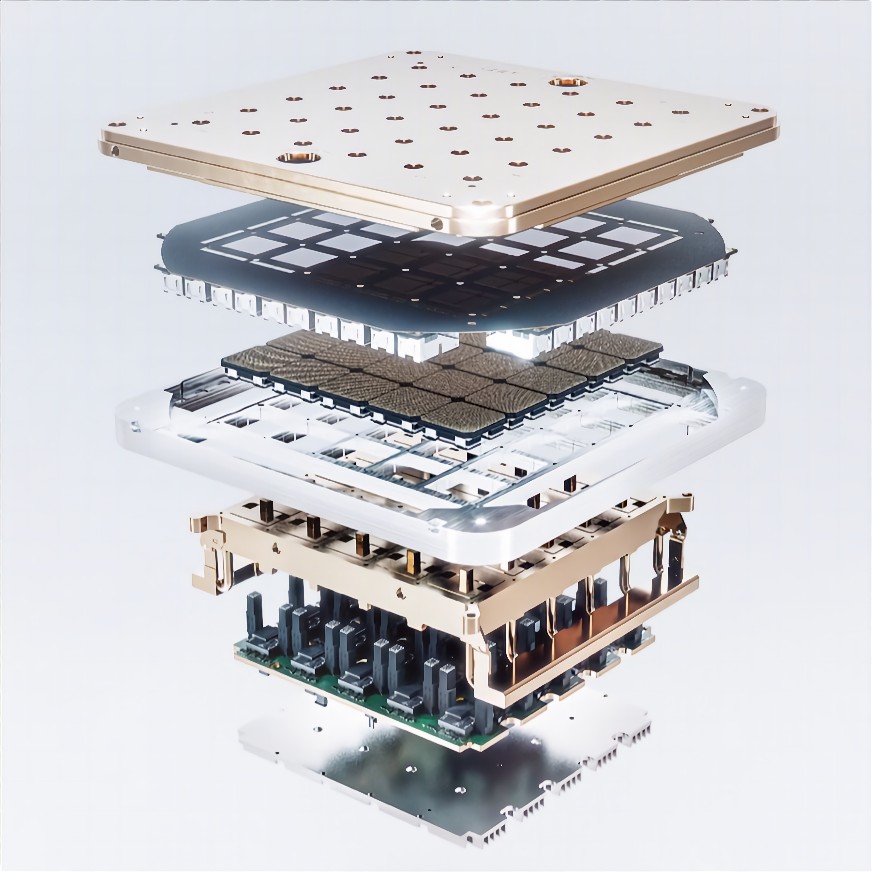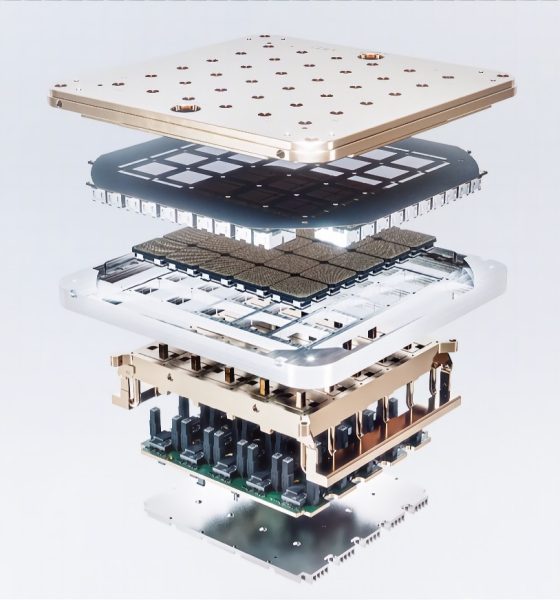

News
Tesla’s in-house Dojo chip teased by legendary engineer ahead of AI Day
Ahead of Tesla’s AI Day scheduled for August 19th, legendary mechanical engineer Dennis Hong has teased a picture of what could be Tesla’s Dojo Chip. While Dojo is a Supercomputer that Tesla Head of Autonomy Andrej Karpathy released photographs of recently, Dojo uses an in-house chip, according to Elon Musk, along with a computer architecture optimized for Neural Net Training.
Hong, who has been a professor at the University of California, Los Angeles Samueli School of Engineering for several years, has an interest in robotic platforms, autonomous vehicles, and machine design. Interestingly, in 2011, Hong presented a TED Talk about the possibilities of making a car for blind people. During the presentation, Hong told attendees about the DARPA Urban Challenge, where he and his team of engineers developed a fully autonomous car that would automatically reach its destination without intervention. In 2007, when the Urban Challenge was completed, Hong and Co. placed third in the competition, taking home a cool $500,000 prize to continue developing self-driving techniques, among other things.
Hong dished out some added anticipation to Tesla’s AI Day event by sending out a picture of what is likely the in-house chip that Musk talked about in September 2020. “Dojo uses our own chips,” Musk said. Unlike most automakers, Tesla aims to develop most of its software and hardware in-house, especially when it comes to its autonomy projects. While Hong was unwilling to confirm or deny what his professional relationship with Tesla is, his expertise could likely have contributed to the development of Dojo and the autonomous driving project that the company has worked on for years.
#Tesla #AI day
August 19, 2021
Palo Alto, CA
5 p.m. PDT pic.twitter.com/4zsP9cVxh5— Dennis Hong (@DennisHongRobot) August 3, 2021
Tesla has been developing its own chips since 2016, led by Jim Keller. Ultimately, Tesla wanted to design chips in-house so it knew all of the components and could likely sell the chip to other manufacturers later on. In 2019 at Autonomy Day, it unveiled Hardware 3.0, a chip that Elon Musk said was “objectively the best chip in the world.” Earlier this year, it was rumored that Tesla was working with Samsung to develop a new 5nm semiconductor chip that would assist with autonomous driving software.
Dojo is undoubtedly being developed in-house, but that does not mean Tesla will not attempt to gain the expertise and experience of some of the world’s most intelligent and accomplished engineers. With at least 14 years of experience in the field of self-driving cars, Hong may be the perfect candidate to help Tesla perfect and unveil the future of autonomous driving later this month. At AI Day, it is unknown what will be talked about or released as of right now, but there is obvious speculation that details regarding Tesla’s long-awaited Dojo could be released.
After announcing Dojo last year, Musk and Co. have remained relatively quiet regarding its development, but the company has continuously released updates to its Full Self-Driving Beta suite. Musk says updates will come “every 2 weeks on Friday” at midnight Pacific Standard Time.
Despite Tesla’s development and incremental improvements with nearly every software update, it is nowhere near completed. Instead, the strategy was to transition Tesla’s entire FSD strategy from what Musk called ~2.5D to 4D. Essentially, Musk wanted to transition the FSD Neural Network to a video format. Adding timestamps for more accuracy, the complexity of Dojo is likely something that will not only improve the accuracy of Tesla’s vehicles when FSD and Autopilot are operational, but it also will increase performance at a more drastic rate due to the increased rate of data capture. The massive amount of data that Dojo will comprehend requires one of the world’s strongest and most robust computer systems.
While Tesla hinted toward the release of Dojo late last year, it will not be ready until late 2021 at the earliest. It is unknown if Tesla will unveil Dojo at the event or give a simple progress update.

Elon Musk
Elon Musk’s X will start using a Tesla-like software update strategy
The initiative seems designed to accelerate updates to the social media platform, while maintaining maximum transparency.

Elon Musk’s social media platform X will adopt a Tesla-esque approach to software updates for its algorithm.
The initiative seems designed to accelerate updates to the social media platform, while maintaining maximum transparency.
X’s updates to its updates
As per Musk in a post on X, the social media company will be making a new algorithm to determine what organic and advertising posts are recommended to users. These updates would then be repeated every four weeks.
“We will make the new 𝕏 algorithm, including all code used to determine what organic and advertising posts are recommended to users, open source in 7 days. This will be repeated every 4 weeks, with comprehensive developer notes, to help you understand what changed,” Musk wrote in his post.
The initiative somewhat mirrors Tesla’s over-the-air update model, where vehicle software is regularly refined and pushed to users with detailed release notes. This should allow users to better understand the details of X’s every update and foster a healthy feedback loop for the social media platform.
xAI and X
X, formerly Twitter, has been acquired by Elon Musk’s artificial intelligence startup, xAI last year. Since then, xAI has seen a rapid rise in valuation. Following the company’s the company’s upsized $20 billion Series E funding round, estimates now suggest that xAI is worth tens about $230 to $235 billion. That’s several times larger than Tesla when Elon Musk received his controversial 2018 CEO Performance Award.
As per xAI, the Series E funding round attracted a diverse group of investors, including Valor Equity Partners, Stepstone Group, Fidelity Management & Research Company, Qatar Investment Authority, MGX, and Baron Capital Group, among others. Strategic partners NVIDIA and Cisco Investments also continued support for building the world’s largest GPU clusters.
News
Tesla FSD Supervised wins MotorTrend’s Best Driver Assistance Award
The decision marks a notable reversal for the publication from prior years, with judges citing major real-world improvements that pushed Tesla’s latest FSD software ahead of every competing ADAS system.

Tesla’s Full Self-Driving (Supervised) system has been named the best driver-assistance technology on the market, earning top honors at the 2026 MotorTrend Best Tech Awards.
The decision marks a notable reversal for the publication from prior years, with judges citing major real-world improvements that pushed Tesla’s latest FSD software ahead of every competing ADAS system. And it wasn’t even close.
MotorTrend reverses course
MotorTrend awarded Tesla FSD (Supervised) its 2026 Best Tech Driver Assistance title after extensive testing of the latest v14 software. The publication acknowledged that it had previously criticized earlier versions of FSD for erratic behavior and near-miss incidents, ultimately favoring rivals such as GM’s Super Cruise in earlier evaluations.
According to MotorTrend, the newest iteration of FSD resolved many of those shortcomings. Testers said v14 showed far smoother behavior in complex urban scenarios, including unprotected left turns, traffic circles, emergency vehicles, and dense city streets. While the system still requires constant driver supervision, judges concluded that no other advanced driver-assistance system currently matches its breadth of capability.
Unlike rival systems that rely on combinations of cameras, radar, lidar, and mapped highways, Tesla’s FSD operates using a camera-only approach and is capable of driving on city streets, rural roads, and freeways. MotorTrend stated that pure utility, the ability to handle nearly all road types, ultimately separated FSD from competitors like Ford BlueCruise, GM Super Cruise, and BMW’s Highway Assistant.
High cost and high capability
MotorTrend also addressed FSD’s pricing, which remains significantly higher than rival systems. Tesla currently charges $8,000 for a one-time purchase or $99 per month for a subscription, compared with far lower upfront and subscription costs from other automakers. The publication noted that the premium is justified given FSD’s unmatched scope and continuous software evolution.
Safety remained a central focus of the evaluation. While testers reported collision-free operation over thousands of miles, they noted ongoing concerns around FSD’s configurable driving modes, including options that allow aggressive driving and speeds beyond posted limits. MotorTrend emphasized that, like all Level 2 systems, FSD still depends on a fully attentive human driver at all times.
Despite those caveats, the publication concluded that Tesla’s rapid software progress fundamentally reshaped the competitive landscape. For drivers seeking the most capable hands-on driver-assistance system available today, MotorTrend concluded Tesla FSD (Supervised) now stands alone at the top.
News
Elon Musk’s Grokipedia surges to 5.6M articles, almost 79% of English Wikipedia
The explosive growth marks a major milestone for the AI-powered online encyclopedia, which was launched by Elon Musk’s xAI just months ago.

Elon Musk’s Grokipedia has grown to an impressive 5,615,201 articles as of today, closing in on 79% of the English Wikipedia’s current total of 7,119,376 articles.
The explosive growth marks a major milestone for the AI-powered online encyclopedia, which was launched by Elon Musk’s xAI just months ago. Needless to say, it would only be a matter of time before Grokipedia exceeds English Wikipedia in sheer volume.
Grokipedia’s rapid growth
xAI’s vision for Grokipedia emphasizes neutrality, while Grok’s reasoning capabilities allow for fast drafting and fact-checking. When Elon Musk announced the initiative in late September 2025, he noted that Grokipedia would be an improvement to Wikipedia because it would be designed to avoid bias.
At the time, Musk noted that Grokipedia “is a necessary step towards the xAI goal of understanding the Universe.”
Grokipedia was launched in late October, and while xAI was careful to list it only as Version 0.1 at the time, the online encyclopedia immediately earned praise. Wikipedia co-founder Larry Sanger highlighted the project’s innovative approach, noting how it leverages AI to fill knowledge gaps and enable rapid updates. Netizens also observed how Grokipedia tends to present articles in a more objective manner compared to Wikipedia, which is edited by humans.
Elon Musk’s ambitious plans
With 5,615,201 total articles, Grokipedia has now grown to almost 79% of English Wikipedia’s article base. This is incredibly quick, though Grokipedia remains text-only for now. xAI, for its part, has now updated the online encyclopedia’s iteration to v0.2.
Elon Musk has shared bold ideas for Grokipedia, including sending a record of the entire knowledge base to space as part of xAI’s mission to preserve and expand human understanding. At some point, Musk stated that Grokipedia will be renamed to Encyclopedia Galactica, and it will be sent to the cosmos.
“When Grokipedia is good enough (long way to go), we will change the name to Encyclopedia Galactica. It will be an open source distillation of all knowledge, including audio, images and video. Join xAI to help build the sci-fi version of the Library of Alexandria!” Musk wrote, adding in a later post that “Copies will be etched in stone and sent to the Moon, Mars and beyond. This time, it will not be lost.”








